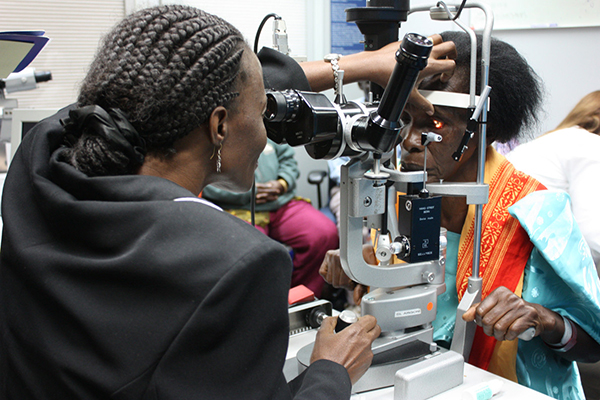High eye pressure does not always cause glaucoma, but it is a significant risk factor. Lowering high eye pressure may reduce the risk, although glaucoma can also occur in people with typical eye pressure.
Glaucoma refers to a set of eye conditions that damage the optic nerve at the back of the eye.
Eye pressure refers to the pressure of fluid in the eye. High eye pressure can increase the risk of glaucoma, which involves high eye pressure that causes damage to the optic nerve.
This article examines the link between eye pressure and glaucoma, symptoms, and when to contact a doctor.
eye pressure, or intraocular pressure, is the pressure of fluids within the eye.
The front part of the eye contains a clear fluid called aqueous humor. Usually, aqueous humor flows in and out of the eye through the drainage angle, maintaining a steady pressure.
If there is an issue with the drainage of aqueous humor, fluid can build up and increase eye pressure. Eye pressure that is too high or too low can damage vision.
High eye pressure increases the riskTrusted Source of glaucoma and can damage the optic nerve, which can lead to vision loss. The optic nerve sits at the back of the eye and sends signals to the brain, allowing people to see.
Managing eye pressure is an important part of managing glaucoma, as reducing high eye pressure can help prevent vision loss.
Some people with high eye pressure will not develop glaucoma, which can also occur in those without high eye pressure. When this occurs, doctors callTrusted Source it normal-tension glaucoma.
Learn more about normal-tension glaucoma.
What is the typical glaucoma eye pressure range?
According to the National Eye Institute (NEI)Trusted Source, the eye pressure range for developing glaucoma can vary from person to person.
In some cases, people with high eye pressure will not develop glaucoma, though some without high eye pressure may develop glaucoma. This is because the level of pressure that the optic nerve can tolerate varies with each person.
Typical eye pressure ranges from 10 to 20 millimeters of mercury (mm Hg). Eye doctors generally consider a measurement above 21 mm Hg as high eye pressure.
People with high eye pressure but no signs of damage have ocular hypertension. Ocular hypertension involves no signs of vision loss or damage to the optic nerve, but individuals have an increased risk of glaucoma.
Glaucoma occurs if high eye pressure damages the optic nerve.
Get our Eye Health Newsletter
Receive expert advice, tips to manage your symptoms, and the latest on condition breakthroughs delivered straight to your inbox.
Enter your email
Also sign up for our popular Heart Health newsletter
Your privacy is important to us
What is dangerously high eye pressure?
There is no set levelTrusted Source of high eye pressure that causes glaucoma and no level of lower eye pressure that will prevent the risk of glaucoma. However, high eye pressure is a significant risk factor for glaucoma.
The NEI states that a level of eye pressure that is too high depends on the individual. Every person’s optic nerve can handle a different amount of pressure.
If people have high eye pressure, managing and lowering eye pressure may be necessary to prevent damage from occurring or worsening.
In people with glaucoma, the target range for lowering eye pressure may also change over time and may need lowering further to prevent glaucoma from progressing.
Symptoms of high eye pressure and glaucoma
High eye pressure, or ocular hypertension, does not usually cause noticeable symptoms. People may have high eye pressure without realizing it, so regular eye exams are important.
People may also be unaware of having glaucoma, as in the early stages of the condition, it does not usuallyTrusted Source cause symptoms. When symptoms develop, they may be so slow that individuals do not notice them.
Over time, a person may gradually start to lose their vision. This can begin with peripheral vision, particularly the vision that is closest to the nose. Individuals may also notice blind spots in their vision.
If glaucoma worsens, it can cause the loss of peripheral vision. Without treatment, glaucoma can ultimately lead to blindness.
When to speak with a doctor
High eye pressure and glaucoma may not cause any symptoms at first, so it is important to get regular eye exams. A doctor will measure eye pressure and check the optic nerve for any signs of damage.
It is also important for people with a family history of glaucoma to attend regular eye exams. If someone has concerns about changes to their vision, they can speak with a doctor or eye specialist.
Early diagnosis and treatment are important to lower eye pressure and prevent vision loss or optic nerve damage.
If people have glaucoma, starting treatment as soon as possible can help preventTrusted Source vision loss or stop vision from worsening.
Angle-closure glaucoma is a less common type of glaucoma that may not cause any symptoms until people experience an acute attack.
Acute angle-closure glaucoma is a medical emergencyTrusted Source that may cause a sudden onset of the following symptoms:
severe eye pain
headache
blurry or decreased vision
seeing halos of light or rainbows
nausea
vomiting
Summary
High eye pressure can increase the risk of glaucoma but does not guarantee a person will develop it. Lowering high eye pressure is important to prevent vision loss and damage to the optic eye.
If people have glaucoma, managing eye pressure can help prevent further damage and vision loss.
In the early stages, high eye pressure and glaucoma may not cause any symptoms. However, individuals need to attend regular eye exams to check for high eye pressure or signs of glaucoma.
